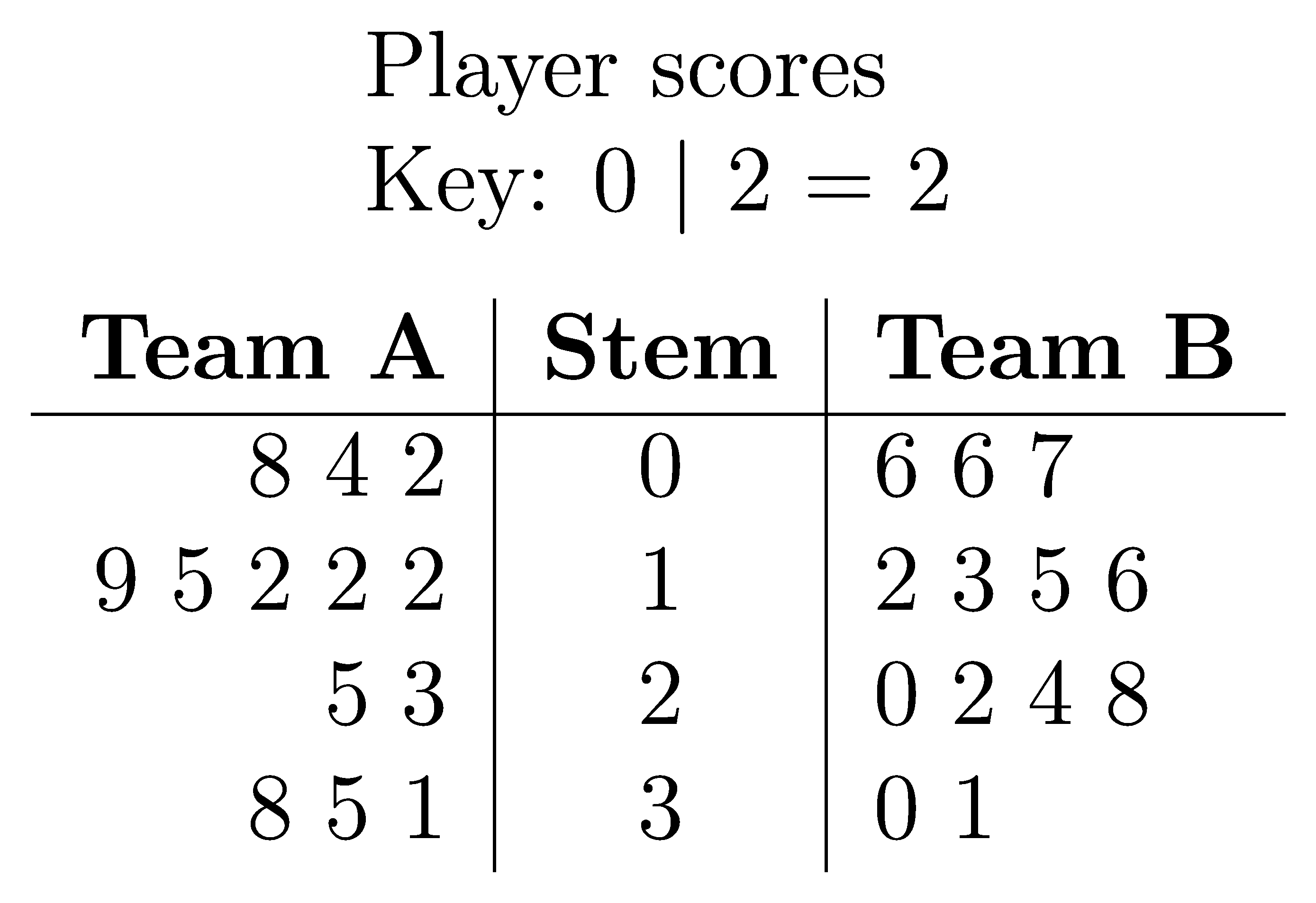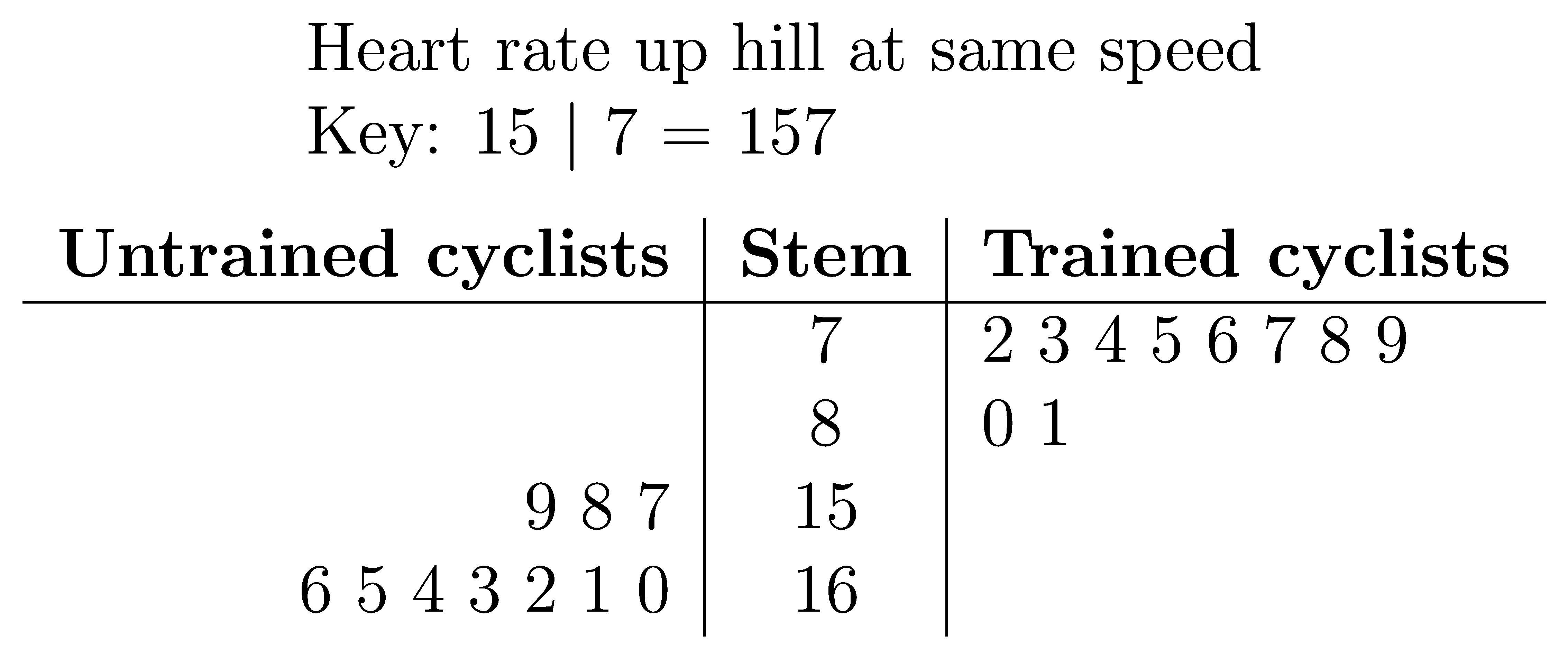7. Stem and Leaf plot: back-to-back
An example of a back-to-back stem and leaf plot is below.
The python file to make a back-to-back stem and leaf plot is below.
The required LaTeX files are below.
The custom python modules required are:
A sample text file is below:
7.1. Example back-to-back stem and leaf plots
7.2. LaTeX
The .tex file template is shown below.
from pathlib import Path
import subprocess
from tkinter import filedialog
import time
import magick_pdf_to_png
from collections import namedtuple
currfile_dir = Path(__file__).parent
tex_template_path = currfile_dir / "stem_and_leaf_btb_template.tex"
# named tuple for main data to be passed easily from one function to the next and used vai dot notation insetad of using a dictionary with keys.
Keydata = namedtuple("Keydata", ["keystem", "keyleaf", "keyvalue"])
def convert_to_pdf(tex_path, currfile_dir, aux_path):
"""
Converts a TeX file to PDF format using pdfLaTeX.
Args:
tex_path (str): The path to the TeX file.
currfile_dir (str): The path to the directory where the TeX file is located.
aux_path (str): The path to the directory where auxiliary files will be stored.
Returns:
subprocess.CompletedProcess: A subprocess.CompletedProcess object containing information about the completed process.
Raises:
FileNotFoundError: If the TeX file does not exist.
subprocess.CalledProcessError: If pdfLaTeX returns a non-zero exit code.
"""
result = subprocess.run(
[
"pdfLaTeX",
tex_path,
"-output-directory",
currfile_dir,
"-aux-directory",
aux_path,
],
stdout=subprocess.PIPE,
)
def get_list_from_str(data_string):
if ", " in data_string:
data_list = data_string.split(", ")
elif "," in data_string:
data_list = data_string.split(",")
else:
data_list = data_string.split(" ")
return data_list
def get_list_nums_from_str(num_string_list):
have_dec = any("." in s for s in num_string_list)
if have_dec:
num_list = [float(n) for n in num_string_list]
else:
num_list = [int(n) for n in num_string_list]
return num_list
def make_stem_leaf_dict(num_list, interval):
stem_leaves_dict = dict()
for val in num_list:
stem, leaf = divmod(val, interval)
if stem not in stem_leaves_dict:
stem_leaves_dict[stem] = str(leaf)
else:
stem_leaves_dict[stem] += " " + str(leaf)
return stem_leaves_dict
def combine_stems(dict1, dict2):
stems1 = list(dict1.keys())
stems2 = list(dict2.keys())
full_stem_list = sorted(list(set(stems1 + stems2)))
data = ""
for stem in full_stem_list:
data += f"{dict1.get(stem, '')[::-1]} & {str(stem)} & {dict2.get(stem, '')} \\\\"
return data
def get_key_data(num_list, interval, multiplier, max_dp):
val1 = num_list[0]
stem1, leaf1 = divmod(val1, interval)
key_value = int(str(stem1) + str(leaf1))
if multiplier == 1:
real_key_value = key_value
else:
real_key_value = round(key_value / multiplier, max_dp)
key_data = Keydata(str(stem1), str(leaf1), str(real_key_value))
return key_data
def stemplotdata_btb(num_list, num2_list, interval, multiplier, max_dp):
num_list = sorted(num_list)
num2_list = sorted(num2_list)
# get data
data1 = make_stem_leaf_dict(num_list, interval)
data2 = make_stem_leaf_dict(num2_list, interval)
data = combine_stems(data1, data2)
# get key_data for top of key
key_data = get_key_data(num_list, interval, multiplier, max_dp)
return key_data, data
def get_file_data(filename):
# open the text file and read the numbers
with open(filename) as f:
# read the first line and store it in a variable
main_title = f.readline().strip()
# read the second line and store it in a variable
leaf1_title = f.readline().strip()
# read the third line and store it in a variable
numbers_string = f.readline().strip()
# read the fourth line and store it in a variable
leaf2_title = f.readline().strip()
# read the fifth line and store it in a variable
numbers2_string = f.readline().strip()
#
numbers2_list = get_list_from_str(numbers2_string)
numbers2_list = get_list_nums_from_str(numbers2_list)
#
numbers_list = get_list_from_str(numbers_string)
numbers_list = get_list_nums_from_str(numbers_list)
# get rid of decimals by * by power of 10
# combine lists for factors
both_numbers_list = numbers_list + numbers2_list
max_dp = max(
len(str(x).split(".")[1]) if "." in str(x) else 0 for x in both_numbers_list
)
multiplier = 10**max_dp
new_num_list = [int(x * multiplier) for x in numbers_list]
new_num2_list = [int(x * multiplier) for x in numbers2_list]
# get interval based on no of digits
both_new_num_list = new_num_list + new_num2_list
interval_multiplier = max(len(str(x)) for x in both_new_num_list) - 1
interval = 10**interval_multiplier
# only want 1 in the leaf
if interval > 10:
interval = 10
key_data, data = stemplotdata_btb(
new_num_list, new_num2_list, interval, multiplier, max_dp
)
return main_title, key_data, leaf1_title, leaf2_title, data
def main():
data_filename = filedialog.askopenfilename(initialdir=Path(currfile_dir))
if data_filename == "":
print("Exited, by clicking Cancel")
return
main_title, key_data, leaf1_title, leaf2_title, data = get_file_data(data_filename)
# print(plot_title, numbers_string, numbers_labels, numbers_loop_max)
# Create a Path object from the file path
path_obj = Path(data_filename)
# Get the file name from the Path object using the name attribute
filename = path_obj.stem
# filename = input("Enter the base filename to be added to the prefix dp_: \n")
# if not filename:
# filename = "dp_1"
# set names of files that are made
tex_output_path = currfile_dir / f"{filename}.tex"
pdf_path = currfile_dir / f"{filename}.pdf"
png_path = currfile_dir / f"{filename}.png"
aux_path = currfile_dir / "temp"
# Read in the LaTeX template file
with open(tex_template_path, "r") as infile:
tex_template_txt = infile.read()
# Replace the placeholders in the LaTeX template
tex_template_txt = tex_template_txt.replace("<<title>>", main_title)
tex_template_txt = tex_template_txt.replace("<<keystem>>", key_data.keystem)
tex_template_txt = tex_template_txt.replace("<<keyleaf>>", key_data.keyleaf)
tex_template_txt = tex_template_txt.replace("<<keyvalue>>", key_data.keyvalue)
tex_template_txt = tex_template_txt.replace("<<leaf1_title>>", leaf1_title)
tex_template_txt = tex_template_txt.replace("<<leaf2_title>>", leaf2_title)
tex_template_txt = tex_template_txt.replace("<<data>>", data)
# Write the question tex to an output file
with open(tex_output_path, "w") as outfile:
outfile.write(tex_template_txt)
# Wait for the files to be created
time.sleep(1)
# Convert the LaTeX files to PDFs
convert_to_pdf(tex_output_path, currfile_dir, aux_path)
# Wait for the files to be created
time.sleep(1)
# Convert the PDFs to PNGs
magick_pdf_to_png.convert_pdf_to_png(pdf_path, png_path)
if __name__ == "__main__":
print("starting")
main()
print("finished")
7.3. Txt file
The .txt file is shown below.
2 lines store data:
line 1: the plot title
line 2: the label for the first group of values
line 3: a comma space separated list of numbers
line 4: the label for the second group of values
line 5: a comma space separated list of numbers
Player scores
Team A
2, 4, 8, 12, 12, 12, 15, 19, 23, 25, 31, 35, 38
Team B
6, 6, 7, 12, 13, 15, 16, 20, 22, 24, 28, 30, 31
7.4. Png file
The .png file is shown below.

7.5. Python code
The python code is shown below.
from pathlib import Path
import subprocess
from tkinter import filedialog
import time
import magick_pdf_to_png
from collections import namedtuple
currfile_dir = Path(__file__).parent
tex_template_path = currfile_dir / "stem_and_leaf_btb_template.tex"
# named tuple for main data to be passed easily from one function to the next and used vai dot notation insetad of using a dictionary with keys.
Keydata = namedtuple("Keydata", ["keystem", "keyleaf", "keyvalue"])
def convert_to_pdf(tex_path, currfile_dir, aux_path):
"""
Converts a TeX file to PDF format using pdfLaTeX.
Args:
tex_path (str): The path to the TeX file.
currfile_dir (str): The path to the directory where the TeX file is located.
aux_path (str): The path to the directory where auxiliary files will be stored.
Returns:
subprocess.CompletedProcess: A subprocess.CompletedProcess object containing information about the completed process.
Raises:
FileNotFoundError: If the TeX file does not exist.
subprocess.CalledProcessError: If pdfLaTeX returns a non-zero exit code.
"""
result = subprocess.run(
[
"pdfLaTeX",
tex_path,
"-output-directory",
currfile_dir,
"-aux-directory",
aux_path,
],
stdout=subprocess.PIPE,
)
def get_list_from_str(data_string):
if ", " in data_string:
data_list = data_string.split(", ")
elif "," in data_string:
data_list = data_string.split(",")
else:
data_list = data_string.split(" ")
return data_list
def get_list_nums_from_str(num_string_list):
have_dec = any("." in s for s in num_string_list)
if have_dec:
num_list = [float(n) for n in num_string_list]
else:
num_list = [int(n) for n in num_string_list]
return num_list
def make_stem_leaf_dict(num_list, interval):
stem_leaves_dict = dict()
for val in num_list:
stem, leaf = divmod(val, interval)
if stem not in stem_leaves_dict:
stem_leaves_dict[stem] = str(leaf)
else:
stem_leaves_dict[stem] += " " + str(leaf)
return stem_leaves_dict
def combine_stems(dict1, dict2):
stems1 = list(dict1.keys())
stems2 = list(dict2.keys())
full_stem_list = sorted(list(set(stems1 + stems2)))
data = ""
for stem in full_stem_list:
data += f"{dict1.get(stem, '')[::-1]} & {str(stem)} & {dict2.get(stem, '')} \\\\"
return data
def get_key_data(num_list, interval, multiplier, max_dp):
val1 = num_list[0]
stem1, leaf1 = divmod(val1, interval)
key_value = int(str(stem1) + str(leaf1))
if multiplier == 1:
real_key_value = key_value
else:
real_key_value = round(key_value / multiplier, max_dp)
key_data = Keydata(str(stem1), str(leaf1), str(real_key_value))
return key_data
def stemplotdata_btb(num_list, num2_list, interval, multiplier, max_dp):
num_list = sorted(num_list)
num2_list = sorted(num2_list)
# get data
data1 = make_stem_leaf_dict(num_list, interval)
data2 = make_stem_leaf_dict(num2_list, interval)
data = combine_stems(data1, data2)
# get key_data for top of key
key_data = get_key_data(num_list, interval, multiplier, max_dp)
return key_data, data
def get_file_data(filename):
# open the text file and read the numbers
with open(filename) as f:
# read the first line and store it in a variable
main_title = f.readline().strip()
# read the second line and store it in a variable
leaf1_title = f.readline().strip()
# read the third line and store it in a variable
numbers_string = f.readline().strip()
# read the fourth line and store it in a variable
leaf2_title = f.readline().strip()
# read the fifth line and store it in a variable
numbers2_string = f.readline().strip()
#
numbers2_list = get_list_from_str(numbers2_string)
numbers2_list = get_list_nums_from_str(numbers2_list)
#
numbers_list = get_list_from_str(numbers_string)
numbers_list = get_list_nums_from_str(numbers_list)
# get rid of decimals by * by power of 10
# combine lists for factors
both_numbers_list = numbers_list + numbers2_list
max_dp = max(
len(str(x).split(".")[1]) if "." in str(x) else 0 for x in both_numbers_list
)
multiplier = 10**max_dp
new_num_list = [int(x * multiplier) for x in numbers_list]
new_num2_list = [int(x * multiplier) for x in numbers2_list]
# get interval based on no of digits
both_new_num_list = new_num_list + new_num2_list
interval_multiplier = max(len(str(x)) for x in both_new_num_list) - 1
interval = 10**interval_multiplier
# only want 1 in the leaf
if interval > 10:
interval = 10
key_data, data = stemplotdata_btb(
new_num_list, new_num2_list, interval, multiplier, max_dp
)
return main_title, key_data, leaf1_title, leaf2_title, data
def main():
data_filename = filedialog.askopenfilename(initialdir=Path(currfile_dir))
if data_filename == "":
print("Exited, by clicking Cancel")
return
main_title, key_data, leaf1_title, leaf2_title, data = get_file_data(data_filename)
# print(plot_title, numbers_string, numbers_labels, numbers_loop_max)
# Create a Path object from the file path
path_obj = Path(data_filename)
# Get the file name from the Path object using the name attribute
filename = path_obj.stem
# filename = input("Enter the base filename to be added to the prefix dp_: \n")
# if not filename:
# filename = "dp_1"
# set names of files that are made
tex_output_path = currfile_dir / f"{filename}.tex"
pdf_path = currfile_dir / f"{filename}.pdf"
png_path = currfile_dir / f"{filename}.png"
aux_path = currfile_dir / "temp"
# Read in the LaTeX template file
with open(tex_template_path, "r") as infile:
tex_template_txt = infile.read()
# Replace the placeholders in the LaTeX template
tex_template_txt = tex_template_txt.replace("<<title>>", main_title)
tex_template_txt = tex_template_txt.replace("<<keystem>>", key_data.keystem)
tex_template_txt = tex_template_txt.replace("<<keyleaf>>", key_data.keyleaf)
tex_template_txt = tex_template_txt.replace("<<keyvalue>>", key_data.keyvalue)
tex_template_txt = tex_template_txt.replace("<<leaf1_title>>", leaf1_title)
tex_template_txt = tex_template_txt.replace("<<leaf2_title>>", leaf2_title)
tex_template_txt = tex_template_txt.replace("<<data>>", data)
# Write the question tex to an output file
with open(tex_output_path, "w") as outfile:
outfile.write(tex_template_txt)
# Wait for the files to be created
time.sleep(1)
# Convert the LaTeX files to PDFs
convert_to_pdf(tex_output_path, currfile_dir, aux_path)
# Wait for the files to be created
time.sleep(1)
# Convert the PDFs to PNGs
magick_pdf_to_png.convert_pdf_to_png(pdf_path, png_path)
if __name__ == "__main__":
print("starting")
main()
print("finished")
